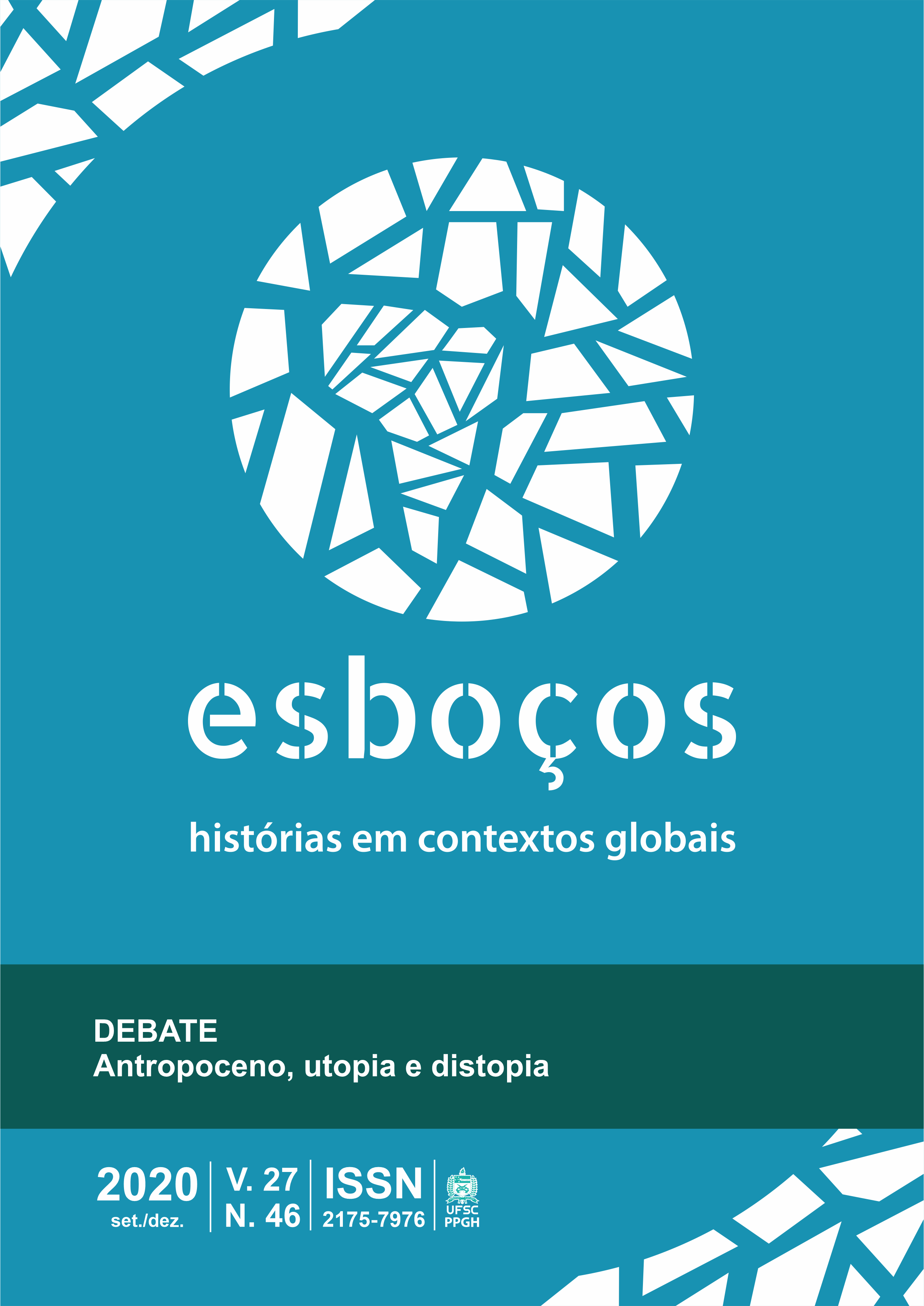Literary visions of post-apocalyptic worlds in the works of Mary Shelley, Margaret Atwood and Maggie Gee
DOI:
https://doi.org/10.5007/2175-7976.2020.e73578Resumo
Once hailed as the pinnacle of evolutionary progress, the human subject has more recently been under severe attack due to the destructive potential that has been unleashed by humans, especially in the last two hundred years. As a result, contemporary literature and art is replete with images of a utopia without humans. Many writers see humans, or rather human destructiveness, as the real plague on the planet and offer visions of utopia placed in the post-apocalyptic post-human era. Drawing on Patricia Vieira’s seminal article titled “Utopia and Dystopia in the Age of the Anthropocene”, I will first discuss how Mary Shelley portrayed ecological awareness in her The Last Man. I will then move on to examine how increasing ecological destruction leads to (post)-apocalyptic visions in the works of Margaret Atwood and Maggie Gee. My aim in juxtaposing two contemporary writers with Mary Shelley is to show that despite their different socio-historical contexts, these women writers have produced works that can not only be read as visionary and cautionary tales but that also promote heightened ecological awareness as an antidote to destructive and – ultimately – self-destructive tendencies of humankind.
Referências
ATWOOD, Margaret. Oryx and Crake. London: Virago Press, 2003.
CRIST, Eileen. On the Poverty of Our Nomenclature. In: MOORE, Jason (ed.). Anthropocene or Capitolocene: Nature, History, and the Crisis of Capitalism. Oakland: Kairos, 2016. p. 14-34.
DEMOS, T.J. Anthropocene, Capitolocene, Gynocene: The Many Names of Resistance. Frontiers of Solitude, September 11, 2016. Available at: http://frontiersof-solitude.org/blog/442.
GEE, Maggie. The Ice People. London: TelegramBooks, 2008.
GRIMBEEK, Marinette. Margaret Atwood’s Environmentalism: Apocalypse and Satire in the MaddAddam Trilogy. Doctoral Thesis. Karlstad University Studies. 2017.
HARLAND, Paul W. Ecological Grief and Therapeutic Storytelling in Margaret Atwood’s MaddAddam Trilogy. Interdisciplinary Studies in Literature and Environment, Oxford, v. 23, n. 3, p. 583-602, 2016.
HARRAWAY, Donna. Staying with the Trouble: Anthropocene, Capitalocene, Chthulucene. In: MOORE, Jason (ed.). Anthropocene or Capitolocene: Nature, History, and the Crisis of Capitalism. Oakland: Kairos, 2016. p. p. 34-78.
HOPE, Jennings. The Comic Apocalypse of The Year of the Flood. Margaret Atwood Studies, Dayton, v. 3, n. 2, p. 11-18, 2010.
JOHNS-PUTRA, Adeline. Care, Gender and the Climate-Changed Future: Maggie Gee’s The Ice People. CANAVAN, Gerry; ROBINSON, Kim Stanley. Green planets: ecology and science fiction. Middletown: Wesleyan, 2014. p. 127-142.
KU, Chung-Hao. Of Monster and Man: Transgenenics and Transgression in Margaret Atwood’s Oryx and Crake. Concentric: Literary and Cultural Studies, Taipei, v. 32, n.1, p. 107-133, January 2006.
MCKIBBEN, Bill. The End Of Nature. Broadway: Random House, 1989.
MCWHIR, Anne (ed.). Introduction. SHELLEY, Mary. The Last Man. Ontario: Broadview Literary Texts, 1996.
MOORE, Jason W. Introduction. In: MOORE, Jason W. (ed.) Anthropocene or Capitalocene: Nature, History, and the Crisis of Capitalism. Oakland: Kairos, 2016a. p. 1-11.
MOORE, Jason W. The Rise of Cheap Nature. In: MOORE, Jason W. (ed.) Anthropocene or Capitalocene: Nature, History, and the Crisis of Capitalism. Oakland: Kairos, 2016b. p. 78-115.
NORTHOVER, Alan. Strangers in Strange Worlds: Margaret Atwood’s MaddAddam Trilogy. Journal of Literary Studies, Pretoria, v. 33, n. 1, p. 121-137, 2017.
POSNER, Richard. The End is Near (reviewing Margaret Atwood, Oryx and Crake: A Novel (2003)). New Republic, p.31, September 2003.
SCHNEIDERMAN, Jill S. The Anthropocene Controversy. In: GRUSIN, Richard (ed.). Anthropocene Feminism. Minneapolis: University of Minnesota Press, 2017. p. 169-198.
SCRANTON, Roy. Learning to Die in the Anthropocene: Reflections on the End of a Civilization. San Francisco: City Lights Publishers, 2015.
SEPETOĞLU, Selen. Women and Eco-disasters in Maggie Gee’s The Ice People and Sarah Hill’s The Cartullan Army: An Ecofeminist Approach. MA Thesis. Hacettepe, Department of English Language and Literature, Ankara, 2014.
SHELLEY, Mary. The Last Man. London: Wordsworth editions ltd., 2004.
SHELLEY, Percy B. Prometheus Unbound. Seattle: University of Washington Press, 1959.
TREXLER, Adam. Anthropocene Fictions: The Novel in a Time of Climate Change. Charlottesville: University of Virginia Press, 2015.
UYGUR, Mahinur Akşehir. Utopia and Dystopia Intertwined: the Problem of Ecologyin Margaret Atwood’s Oryx and Crake, The Year of the Flood and MaddAddam. The Journal of International Social Research, Samsun, v. 7, n. 31, p. 41-48, May 2014.
VIEIRA, Patrícia. Utopia and Dystopia in the Age of the Anthropocene. Esboços, Florianopólis, v. 27, n. 46, p. 350-365, 2020.
VINCE, Gaia. Adventures in the Anthropocene: A Journey to the Heart of the Planet We Made. Minneapolis: Milkweed editions, 2014.
WASHINGTON, Chris. Romantic Revelations: Visions of Post-apocalyptic Life and Hope in the Anthropocene. Toronto: University of Toronto Press, 2019.
Downloads
Publicado
Como Citar
Edição
Seção
Licença
A reprodução dos textos editados pela Esboços: histórias em contextos globais é permitida sob Licença Creative Commons - Atribuição 4.0 Internacional (CC BY 4.0). Será pedido aos autores que assinem a licença de acesso aberto antes da publicação.
Autores que publicam nesta revista concordam com os seguintes termos:
- Os autores cedem à revista eletrônica Esboços: histórias em contextos globais (ISSN 2175-7976) os direitos exclusivos de primeira publicação, com o trabalho simultaneamente licenciado sob a Licença Creative Commons Atribuição 4.0 Internacional (CC BY 4.0).
- Essa licença permite que terceiros final remixem, adaptem e criem a partir do trabalho publicado desde que atribua o devido crédito de autoria e publicação inicial neste periódico.
- Os autores têm autorização para assumir contratos adicionais separadamente, para distribuição não exclusiva da versão do trabalho publicada neste periódico (ex.: publicar em repositório institucional, em site pessoal, publicar uma tradução ou como capítulo de livro).

Esta obra está licenciada com uma Licença Creative Commons Atribuição 4.0 Internacional.







